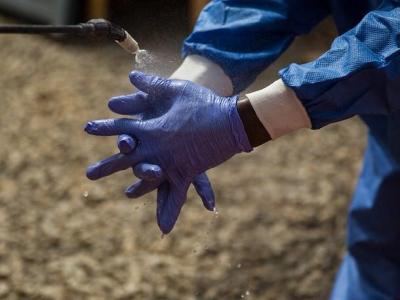Jun 13, 2003 (CIDRAP News) – Donald A. Henderson, MD, MPH, the man who did more than anyone else to eradicate smallpox, sees powerful reasons for both concern and hope in humanity's ancient battle against infectious diseases.
On one hand, with globalization and the threat of bioterrorism, the world now confronts a more dangerous microbial landscape than ever before, Henderson said this week in a lecture at the University of Minnesota in Minneapolis.
On the other hand, the record of immunization programs in developing countries, together with advances in disease prevention and treatment, suggests that the world has a chance to defeat some of the greatest disease threats, he said.
Henderson, now a special advisor to Health and Human Services Secretary Tommy Thompson, spoke Jun 10 after accepting an honorary Doctor of Laws degree from the university for his contributions to public health and public service. He led the global smallpox eradication effort from 1967 to 1977.
"In the 21st century, the potential threat of new and emerging infectious diseases has changed. We don't realize how much that change is," Henderson said. "We must remember that there is a constantly mutating diverse microbiota throughout the world. It regularly throws off new variants . . . into a much more populous world than we had even 20 years ago."
Population growth and globalization are major factors in the emergence of new diseases like SARS (severe acute respiratory syndrome) and the ocean-jumping spread of previously regional diseases like monkeypox, Henderson said.
"The population pressures, the expansion of tourism to remote areas, the internationalization and industrialization of our food supply, together have conspired to create a biologic threat potential that is truly unique in history," he said.
Adding to the dangers is the threat of biological weapons and bioterrorism, he noted. He said the former Soviet Union employed 60,000 scientists in its bioweapons program and kept 30 metric tons of dried smallpox virus on hand. Many of those scientists have moved elsewhere since the Cold War ended. Further, a small country incapable of making nuclear weapons could start a bioweapons program at a cost of only about $250,000, he added.
But amid these worries, Henderson said, "There are equally cogent reasons to believe that we are now poised to take on the challenge of confronting some of the most significant problems of the developing world—AIDS, tuberculosis, malaria, the hemorrhagic fevers."
He said the past 30 years have seen dramatic and not fully appreciated improvements in infectious disease illness and death rates. These improvements are grounds for confidence "that much more is possible if we have the right tools."
When the smallpox eradication campaign was launched in 1967, Henderson and his colleagues estimated it would take no less than 3 years to fully vaccinate the whole population of any of various African countries, he said. "But it soon became apparent that 2 years was ample," and in some countries it took only a year.
"Based on our more recent experience, I would be confident that if one had a vaccine that one wanted to administer continent-wide . . . one could vaccinate 80% [of the population] in 9 months," he said. "It's not an impossible task at all."
Early in the smallpox eradication program, it became apparent that smallpox vaccine and a rather ineffective tuberculosis vaccine were the only immunizations available in many developing countries, Henderson said. "So a few years into the program, we proposed the Expanded Program on Immunization, to make available to children throughout the world diphtheria, pertussis, tetanus, measles, and polio vaccines."
This effort grew so that by 1990, 80% of all children were receiving these vaccines, and some countries were also administering rubella, hepatitis B, haemophilus influenzae, and yellow fever vaccines, he said. As a result, infant mortality declined more dramatically between 1985 and 2000 than ever before.
Henderson said some observers worried that the decreased infant mortality would trigger a population explosion that would only make matters worse than ever. But to everyone's surprise, "Childhood mortality rates fell, and fertility rates fell immediately thereafter. . . . It translated into fewer and healthier children."
In the course of these efforts, Brazil established the practice of having an annual national immunization day when public health agencies would try to vaccinate all children against a given disease, Henderson said. The first time they did it, they vaccinated more than 90% of Brazilian children against polio, he said. The Brazilian example was imitated elsewhere. "National immunization days have now extended throughout the world," he said.
In other hopeful developments, large-scale efforts are now under way to develop vaccines for major diseases, including malaria, AIDS, and tuberculosis, Henderson said. Meanwhile, "mechanisms are being explored to make these vaccines more affordable for the developing world."
Henderson also applauded the growing support for preparedness for public health emergencies in the United States. Federal funds for public health preparedness grew from just $8 million in 1998 to $300 million in 2002. This year the HHS Office of Public Health Preparedness has an overall budget of about $4.5 billion, much of it intended for state and local programs, he said.
He concluded that infectious diseases will remain a difficult challenge for the long haul. Quoting Joshua Lederberg, a Nobel Prize winner and former president of Rockefeller University, he said, "Man's only contenders for dominion of the planet are the viruses, and the ultimate outcome is by no means a foregone conclusion."
Henderson, who formerly directed the Office of Public Health Preparedness, is now a distinguished service professor at the Johns Hopkins School of Public Health and Hygiene in Baltimore.
















